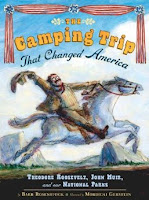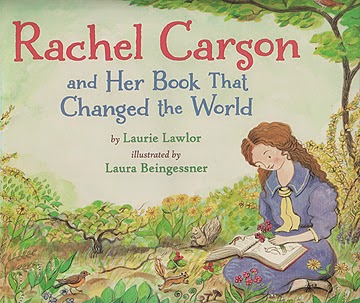
I found another good book for our club.
I didn't expect to like
Rachel Carson and Her Book That Changed the World by
Laurie Lawlor with illustrations by
Laura Beingessner as much as I did. Picture book bios are often problematic to me. They sometimes seem too old for picture book folks, too young for older ones, so who are they for? This one, not so much. Definitely for mid-grade school readers. Maybe third or fourth grade.
The first thing that struck me about this book is that very early on we hear that Rachel as a child explored the outdoors by herself and had a mother who had an interest in nature. This child got her start without any formal environmental instruction, such as we would want for children these days, and, yet, she turned into Rachel Carson.
Another thing I liked about this book, and, yes, this is just me, is that it describes a
woman's story. Carson as a young woman had needy family to deal with. As often happens with achieving women of her era, she had help. In her case, her mother hustled to pull together money for school. She was encouraged by a female college professor. A male superior at the Bureau of Fisheries advised her to submit work to
The Atlantic. She was a professional woman without a personal family. If you read the Epilogue, you'll find that after
Silent Spring was published critics referred to her as "an hysterical woman." Someone asked "why a spinster with no children was so concerned about genetics."
Okay, so maybe I got into this story because of the feminist angle I read into it. But, really, the part in the beginning about simply growing up enjoying the outdoors was very significant, too.
Love the period illustrations, too.

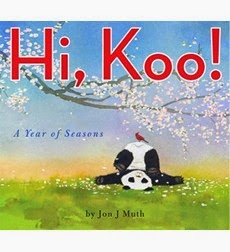 Last week I said that I wasn't stumbling over environmental books on-line now that this year's Earth Day is past. I did, however, stumble upon some at my local library. This week I have a terrific book for our club.
Last week I said that I wasn't stumbling over environmental books on-line now that this year's Earth Day is past. I did, however, stumble upon some at my local library. This week I have a terrific book for our club.
First off, I must say that I am not fond of haiku. That is not a random thought, by the way. Look at this book's title. Anyway, I find haiku kind of confining because of that business of counting the number of syllables and so many syllables per line and three lines and multiply this by that and then divide something, raise to another power, and maybe there's a percentage in there somewhere. I don't actually know.
Jon Muth says he didn't confine himself to the pattern I think of as haiku in Hi, Koo! A Year of Seasons. Instead, he treats haiku "like an instant captured in words--using sensory images." And his sensory images are fantastic.
Now this book is more about children's (and pandas') experience of the different seasons than a hardcore "this is autumn" sort of thing. But we live within nature, too. Leaves that need to be swept up, snow falling off branches, birds making nests, fireflies...every season has something new for kids to do. And the changing events definitely get across the idea of change. And that's seasons, for you. Change, change, change.
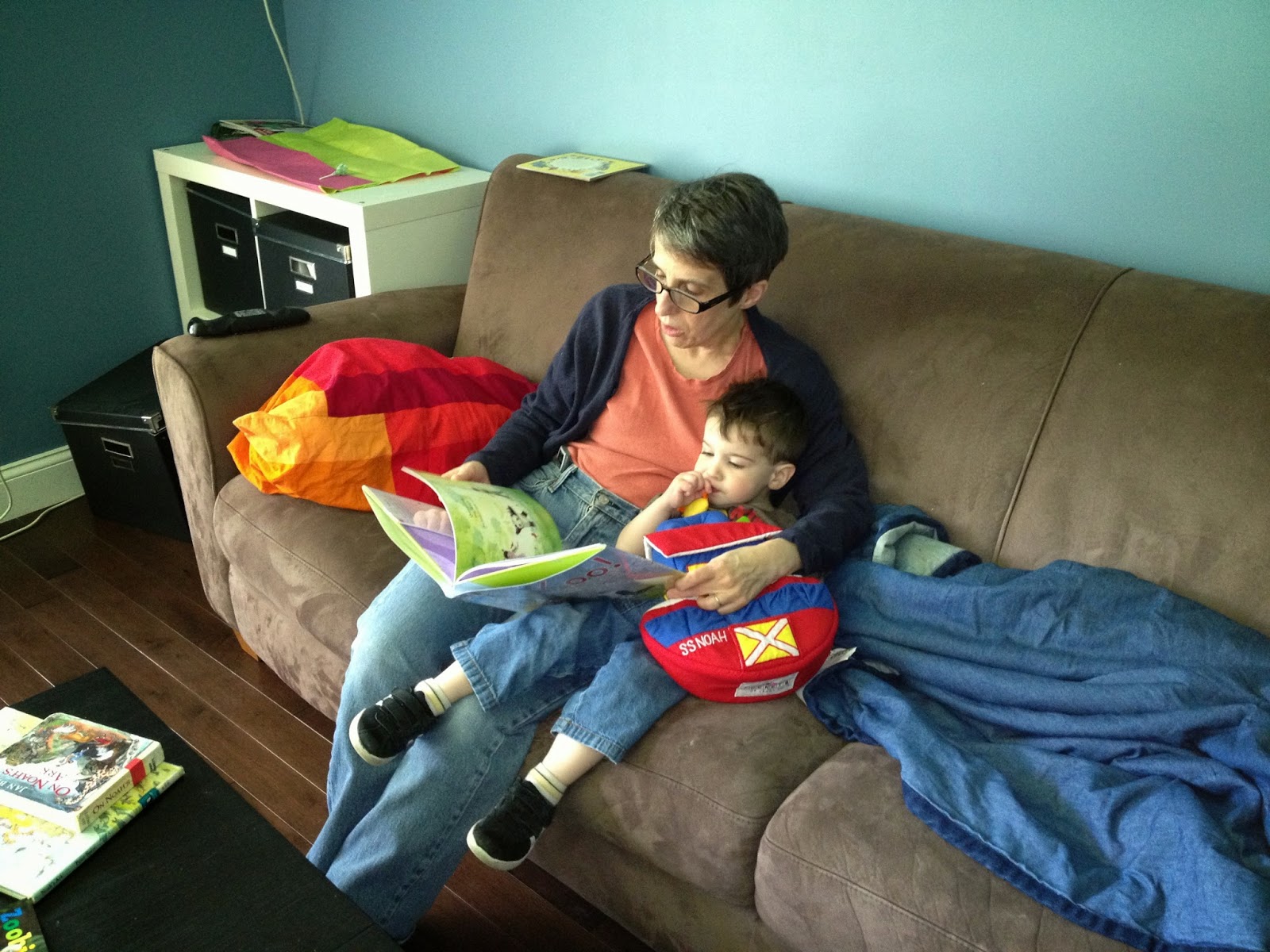
And for really young kids, who aren't ready for picking up on ideas, there's Muth's terrific panda.
 Now that this year's Earth Day is behind us, I'm not stumbling over children's books obviously related to the environment/ecology all over the Internet. Which leads me, again, to be thinking about what kinds of books I should be considering for encouraging an appreciation of the world in children. I still like the idea of providing experience, rather than a lesson.
Now that this year's Earth Day is behind us, I'm not stumbling over children's books obviously related to the environment/ecology all over the Internet. Which leads me, again, to be thinking about what kinds of books I should be considering for encouraging an appreciation of the world in children. I still like the idea of providing experience, rather than a lesson.
I'm also still loving the interview I heard a few weeks ago about Thoreau recording all kinds of information about Concord's flora and fauna. This weekend I'm hoping to get a very young family member started on a Thoreau-like experience, maintaining a nature journal filled with dried leaves and flowers and maybe pictures of that creepy flock of turkeys in his backyard. (Recognizing that turkeys are disturbing is a sort of appreciation.) While I know a wild turkey when I see one, I'm only familiar with a few trees.
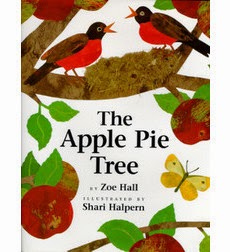 Fortunately, there are books to help with that sort of thing. Scholastic has a whole list of Books for Teaching About Plants and Trees. I'm particularly interested in that apple pie book. When we do our apple tree thing, we can finish with pie.
Fortunately, there are books to help with that sort of thing. Scholastic has a whole list of Books for Teaching About Plants and Trees. I'm particularly interested in that apple pie book. When we do our apple tree thing, we can finish with pie.

 Moral Fibres, a sustainable living blog from the UK (the spelling of fibre vs. fiber was the giveaway), has a review of two environmental books for kids. Wendy read How Does My Garden Grow? by Gerda Muller and The Tomtes of Hilltop Stream by Brenda Tyler. These books are from a Scottish publisher, so they may be difficult to find in this country. But every now and then I like to make an attempt to recognize that the U.S. isn't the only place on the planet that publishes books.
Moral Fibres, a sustainable living blog from the UK (the spelling of fibre vs. fiber was the giveaway), has a review of two environmental books for kids. Wendy read How Does My Garden Grow? by Gerda Muller and The Tomtes of Hilltop Stream by Brenda Tyler. These books are from a Scottish publisher, so they may be difficult to find in this country. But every now and then I like to make an attempt to recognize that the U.S. isn't the only place on the planet that publishes books.
I'm fond of little kid garden books.

 Earth Day is over, but that's no reason to stop reading environmentally themed books. The Horn Book's Recommended Reading For Earth Day list is interesting because it's so long on nonfiction. Plus, the fiction books for older readers all have a post-apocalyptic or at least dystopian thing going on. Monument 14 sounds intriguing, but in a disaster movie sort of way, not an environmental sort of way.
Earth Day is over, but that's no reason to stop reading environmentally themed books. The Horn Book's Recommended Reading For Earth Day list is interesting because it's so long on nonfiction. Plus, the fiction books for older readers all have a post-apocalyptic or at least dystopian thing going on. Monument 14 sounds intriguing, but in a disaster movie sort of way, not an environmental sort of way.
 Walden Warming: Climate Change Comes to Thoreau's Woods isn't a children's book. And I don't know how many people find climate change a riveting subject. But the author, Richard Primack, was involved in a fantastic interview on Science Friday on NPR last week. Guess what Thoreau did? He spent years recording changes in plants in Concord, as well as when birds arrived in the spring. And scientists are using that information today. Doesn't that make you want to start taking notes on something? And hope someone will hold onto it for 160 years?
Walden Warming: Climate Change Comes to Thoreau's Woods isn't a children's book. And I don't know how many people find climate change a riveting subject. But the author, Richard Primack, was involved in a fantastic interview on Science Friday on NPR last week. Guess what Thoreau did? He spent years recording changes in plants in Concord, as well as when birds arrived in the spring. And scientists are using that information today. Doesn't that make you want to start taking notes on something? And hope someone will hold onto it for 160 years?
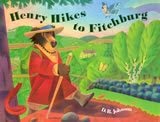 I can make a children's book connection for you. You can introduce your young ones to Henry David Thoreau with D. B. Johnson's lovely books about the naturalist and writer, including Henry Hikes to Fitchburg.
I can make a children's book connection for you. You can introduce your young ones to Henry David Thoreau with D. B. Johnson's lovely books about the naturalist and writer, including Henry Hikes to Fitchburg.


We're experimenting with an Environmental Book Club logo. It may be changing, so don't get attached.
This week I'm directing you to the blog
Picture Books Help Kids Soar where earlier this month Vivian Kirkfield reviewed
Water Can Be by
Laura Purdie Salas. You'll find an excerpt, synopsis, and a list of ways it can be used.
Check out Literacy, Families and Learning's Literature and Environmental Issues: 18 Challenging Picture Books. The blog breaks the eighteen titles into four groups:
- The relationship of people to the environment
- The negative impact of humanity on the environment
- A celebration of the environment, its beauty and wonder
- Environment as creation and the metaphysical experience of our world
Graeme Base makes the list twice.
_____________________
Make your comment in order to be considered for the
Saving the Planet & Stuff giveaway.
The Nature Generation announced its shortlist for the 2014 Green Earth Book Awards. The award is given to books that "best convey the environmental stewardship message to youth" and "inspire children to grow a deeper appreciation, respect, and responsibility for their natural environment."
Winners will be announced on Earth Day.
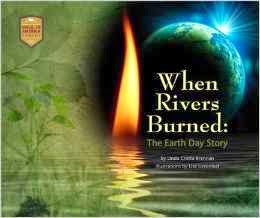 I'm restarting the Environmental Book Club this Earth Day month with When Rivers Burned: The Earth Day Story by Linda Crotta Brennan. This is a lovely book with all kinds of illustrations--photographs, drawings, charts, and text boxes. I feel a little superficial talking first thing about how the book looks, but appearances make a book easier to read, particularly a nonfiction book. When Rivers Burned was also brought out by a smaller publisher, and its appearance is an example of how nice a product they can turn out.
I'm restarting the Environmental Book Club this Earth Day month with When Rivers Burned: The Earth Day Story by Linda Crotta Brennan. This is a lovely book with all kinds of illustrations--photographs, drawings, charts, and text boxes. I feel a little superficial talking first thing about how the book looks, but appearances make a book easier to read, particularly a nonfiction book. When Rivers Burned was also brought out by a smaller publisher, and its appearance is an example of how nice a product they can turn out.
Crotta Brennan does a good job here laying out her material as a narrative. She begins with the pre-Earth Day problems that led to the activism that led to the political action that led to Earth Day. It's not just an environmental book, it's a good beginner nonfiction book. I can see this book being recommended to upper elementary students so they can learn what nonfiction should be and how they should read it.
Only one quibble here--No footnotes or endnotes or bibliography. However, over the last ten years or so I've been seeing nonfiction without footnotes. So there may be something going on in nonfiction publishing that I'm just not aware of.
Transparency issue: I do know Linda Crotta Brennan in a say-hello-at-a-conference sort of way. I got this book through the library, not through Linda or her publisher.
Last week's Environmental Book Club post dealt with The Camping Trip That Changed America by Barb Rosenstock. It's an account of the famous Teddy Roosevelt/John Muir camping trip.
As luck would have it, PBS is running a series this week, The National Parks: America's Best Idea and who should be mentioned in it but John Muir? The show runs for five nights, and I've only watched a few moments here and there on two of them. I believe Muir was talked about both evenings.
This being PBS, a
companion book accompanies the series. Wouldn't it have been terrific if a companion children's book accompanied it as well? Since one doesn't, why not use
The Camping Trip That Changed America?
I don't think you need to be concerned if you've missed the first few nights of
The National Parks: America's Best Idea. This is one of those Ken Burns' deals, so PBS will probably be rerunning it for the rest of this decade. Plus there's a DVD boxed set that you can ask for for Christmas, which is how a lot of PBS programming has ended up on our shelves.
 I found another good book for our club.
I found another good book for our club.


















